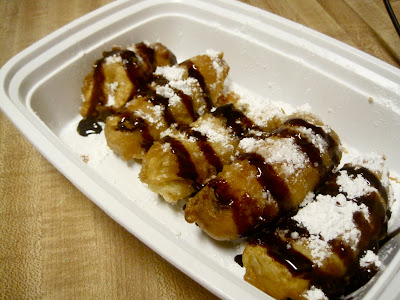My two favorite cuisines start with the letter "I", Indian and Italian. I was half tempted to blog about them just so I have an excuse to eat them, but then I realized I don't need an excuse to eat Italian and/or Indiana food, and decided to try something a little more adventurous, Indonesia. I also haven't virtually traveled to Asia yet, and after falling in love with a Balinese house on House Hunters International , I knew it was the perfect place to stop.
 |
| Balinese house |
Indonesia is made of over 17,000 thousand islands in South East Asia. Indonesia's population of 238 million (of which about 90% are Muslim, the largest in the world) only inhabit about 6,000 islands, the largest including Java, Sumatra, Borneo and its shared islands with Papua New Guinea and Timor.
Since the seventeenth century this archipelago (cluster of islands) has been an importan trade region, attracting marchants, explorers, and pirates from all over the world. Its fertile soil and tropical climate support vast areas of agricultural crops and wilderness. Indonesia is the third largest producer of coffee, second largest producer of palm-oil, has the worlds second highest level of biodiveristy, and is a huge sugar producer. The influence from traders and colonist has resulted in diverse and unique cuisine. To understand all the dynamic influences in Indonesia we need a quick history lesson.
 |
| Borobudur Temple a Buddhist monument in Yogyakarta |
Indonesia's geographic location fosters international which has been the foundation of its history. Business with Chinese and Indian Kingdoms started several centuries BCE, and from them religious and cultural influences were imported. In inland Java, Buddhist and Hindu dynasties flourished. The use of noodles, tea, and stir-frying method is still evident in Indonesian cuisine. Eastern Indonesia was dubbed "Spice Islands" by the Hindi traders and missionaries brought curries, mangos, and a boat load spices, like ginger, cumin, cardamom, coriander and fennel. Around the 1400's the Muslims from the Middle East joined the party. Islamic populations first were first evident in the northern part of Sumatra, with other Indonesian areas adopting it gradually. Nutmeg, a native plant, was once a highly regarded and costly spice in Europe, and was said that it could ward off the plague. In 1512 Portuguese explorer Francisco Serrao decided he wanted to control all the nutmeg and took control of the trading routes. Then the Dutch and British traders decided they wanted some nutmeg too, and the trio dominated the trading post. The Dutch eventually became the dominant player and in the 1800's they took over Indonesia as a colony. Japan ended that rule with the occupation of the archipelago during World War II. Finally, in 1945 Indonesia was recognized as an independent state!
 |
| jackfruit |
At the Indonesian restaurant I went this past weekend one of our servers told us that everyone in the country eats the same food. If you think about this, this is pretty rare. Status can often be seen in the food that people eat. In the US foods like caviar is seen exclusive to the elite, whereas something like Easy Mac is seen primarily for college students, and lower class. However that barrier is torn down in Indonesian culture. So, although many groups have come and gone, leaving their footprints in Indonesian culture, one thing remains the same, in Indonesia.... good food can be enjoyed by everyone!
RECIPE TIME!!
 |
| my food! |
 |
| burbur sum-sum |
As the sweet and thoughtful person that I wanted to bring a snack to my study group. So for my Monday night study table I brought pisang goreng, fried banana fritters, a popular snack sold by vendors throughout Indonesia. The Portuguese introduced flour into the region which enables the banana's, that were never eaten cooked prior, to be fried. I used the Asian bananas recommended by Indonesian website, but I found the texture to be dry. I was hoping they would be more sweeter. So I added powdered sugar and chocolate syrup. They look a lot sweet and better than they actually were.
Next time I would definitely make it with a regular banana.
Pisang Goreng
serves 4-6
Ingredients:
- 1/2 cup of all purpose flour
- 1/2 cup of rice flour
- 2 tablespoons of sugar
- 1/4 teaspoon of salt
- 1 teaspoon of baking powder
- 1 egg, beaten
- 1/2 cup of coconut milk
- 1/2 cup of water
- 2 tablespoons butter, melted
- 6 ripe bananas, or little bananas found in Latin and Asian grocers
- oil for frying
- optional: powdered sugar and chocolate syrup
Directions:
- In a large bowl combine flour, rice flour, baking powder, salt and sugar.
- Pour in egg, coconut milk, water, and butter into the flour mixture. Set aside.
- Heat oil in a deep skillet or deep fryer.
- Peel bananas and cut each banana in two pieces.
- Working in batches dip pieces of banana in the batter to cover. Drop into the hot oil and fry until golden brown and crispy
- Remove from oil and drain on paper towels.
- Sprinkle with powdered sugar and chocolate syrup
- Eat warm!


No comments:
Post a Comment